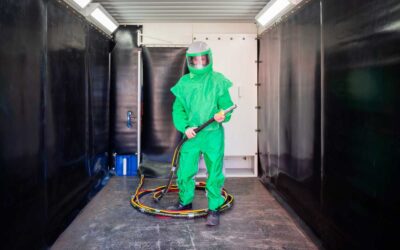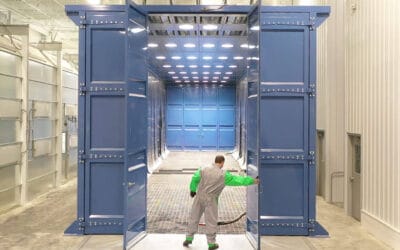Meeting OSHA Standards with a Properly Designed Blast Room
When it comes to abrasive blasting, efficiency and surface finish are critical, but they’re not the only priorities. Worker safety and regulatory compliance play an equally important role in shaping how a blast room is designed, installed, and operated. The Occupational Safety and Health Administration (OSHA) sets strict requirements around airborne contaminants, noise, ventilation, and personal protection, all of which must be addressed to create a safe and compliant blasting environment.
A properly designed blast room not only helps protect employees but also shields businesses from fines, liability, and costly downtime. Below, we’ll explore the most important OSHA standards that apply to abrasive blasting, and how thoughtful blast room design ensures those requirements are met.
Why OSHA Standards Matter in Abrasive Blasting
Abrasive blasting generates high-velocity dust, noise, and rebound particles that can pose significant health and safety hazards. Without proper controls, workers may be exposed to:
- Respirable dust and silica, which can lead to long-term lung disease.
- Excessive noise, often exceeding safe decibel limits.
- Eye and skin injuries from ricocheting abrasive.
- Trip and slip hazards caused by poor housekeeping and abrasive buildup.
OSHA regulations are designed to mitigate these risks. Compliance isn’t optional, violations can result in severe fines, shutdowns, or lawsuits. More importantly, a safe, compliant blast room helps companies retain skilled workers and maintain smooth operations.
Key OSHA Requirements for Blast Rooms
1. Air Quality and Dust Control
One of OSHA’s primary concerns in blasting operations is airborne contaminants. Dust generated during blasting can contain respirable crystalline silica, heavy metals (from coatings), or other toxic particulates.
Relevant OSHA standards:
- 29 CFR 1910.94(a): Ventilation requirements for abrasive blasting.
- 29 CFR 1910.1000: Air contaminants exposure limits.
- 29 CFR 1926.1153: Respirable crystalline silica standard.
Blast room design considerations:
- A high-efficiency dust collection system is essential for keeping dust levels below OSHA’s permissible exposure limits (PELs).
- Continuous airflow should move dust away from the operator’s breathing zone toward extraction points.
- Cross-draft or downdraft ventilation designs are preferred for evenly pulling dust through the blast room.
- Dust collector filters should meet minimum efficiency reporting values (MERV 16 or higher is recommended).
2. Ventilation Rates
Proper ventilation isn’t just about filtration, it’s about maintaining a consistent flow of clean air through the blast room. OSHA requires that ventilation systems are capable of capturing and removing dust at the point of generation.
Blast room best practices:
- Ensure the airflow velocity is sufficient to prevent dust clouds from lingering.
- Position return air plenums and ductwork to avoid dead zones where dust can accumulate.
- Use pressure monitors on dust collectors to alert operators when filters are clogged or airflow is compromised.
3. Noise Exposure
Blasting operations typically generate noise levels well above OSHA’s permissible exposure limit of 90 dBA over an 8-hour shift (29 CFR 1910.95). Without proper noise control measures, workers may be at risk for permanent hearing damage.
Noise-reduction strategies in blast rooms:
- Acoustic paneling inside walls and ceilings to absorb sound.
- Vibration-isolated mounts for motors, fans, and abrasive recovery systems.
- Dust collector mufflers to reduce exhaust noise.
- Selecting appropriate blasting media and nozzle pressures, since harder abrasives and higher pressures generate more noise.
Employers are also required to implement a hearing conservation program when noise exceeds 85 dBA, which includes regular audiometric testing and the use of hearing protection devices.
4. Operator Protection and PPE
Even with engineering controls in place, operators must use personal protective equipment (PPE) that meets OSHA requirements.
OSHA mandates PPE such as:
- Blast helmets and supplied-air respirators.
- Hearing protection (earplugs or earmuffs).
- Protective clothing, such as leather or heavy-duty suits to guard against ricochet.
- Gloves and boots designed for abrasive resistance.
Blast rooms should include dedicated breathing air supply systems that meet Grade D breathing air standards to ensure clean, safe airflow to helmets.
5. Housekeeping and Abrasive Recovery
Another OSHA concern is workplace housekeeping. Loose abrasive on floors presents a slip hazard and creates additional dust.
How blast rooms address this:
- Media recovery systems (such as sweep-in, partial, or full-floor recovery) keep floors clear of abrasive buildup.
- Automated reclaim systems reduce the need for manual shoveling, which lowers worker fatigue and exposure.
- Proper housekeeping procedures should also be documented and enforced as part of OSHA compliance.
6. Fire and Explosion Prevention
Some blasting operations involve combustible dusts or flammable coatings. OSHA requires safeguards against explosions and fire hazards in these cases.
Blast room fire safety measures:
- Dust collectors with explosion venting or suppression systems.
- Non-sparking equipment when blasting aluminum or magnesium.
- Proper grounding to prevent static discharge.
Custom blast rooms can be engineered with these protections built in, ensuring compliance with OSHA as well as NFPA (National Fire Protection Association) standards.
Designing a Blast Room with OSHA in Mind
Meeting OSHA standards is not just about checking boxes, it requires integrating safety into every aspect of the blast room’s design. A few critical elements include:
- Custom ventilation layouts that match the size and shape of the blast room.
- High-performance dust collection designed to meet specific media and coating types.
- Ergonomic controls that reduce operator strain.
- Safety procedures and monitoring systems to prevent equipment from running under unsafe conditions.
A properly designed blast room takes into account the specific materials being blasted, the type of abrasive media, throughput requirements, and the facility’s layout.
The Cost of Non-Compliance
Failing to meet OSHA standards can have serious consequences, including:
- Fines and penalties: OSHA violations can cost thousands of dollars per incident.
- Work stoppages: Unsafe conditions may trigger shutdowns until compliance is achieved.
- Worker turnover: Employees are less likely to stay in environments where safety is not prioritized.
- Reputation damage: Non-compliance can affect customer confidence and industry standing.
Investing in a compliant blast room design from the start avoids these pitfalls and ensures long-term operational stability.
Airblast AFC’s Approach to Compliance and Efficiency
Designing a blast room that meets OSHA standards requires deep technical expertise in airflow, dust collection, noise control, and safety systems. Companies often discover that off-the-shelf equipment doesn’t adequately address regulatory requirements.
Airblast AFC has decades of experience designing and installing custom blast rooms that integrate compliance with performance. Every system is tailored to meet OSHA standards while ensuring efficiency, durability, and ease of operation.
Final Thoughts
Meeting OSHA standards isn’t just a box to check—it’s a commitment to worker safety, productivity, and long-term business success. A blast room that is properly designed and equipped ensures that air quality, noise, ventilation, PPE, and housekeeping all meet strict OSHA requirements. Whether you’re planning a new installation or upgrading an existing facility, keeping compliance in mind from the start will save money, improve operations, and protect your workforce.
If you’d like guidance on designing a compliant and efficient blast room, the team at Airblast AFC is here to help. Contact us today to discuss the best options for your facility.


